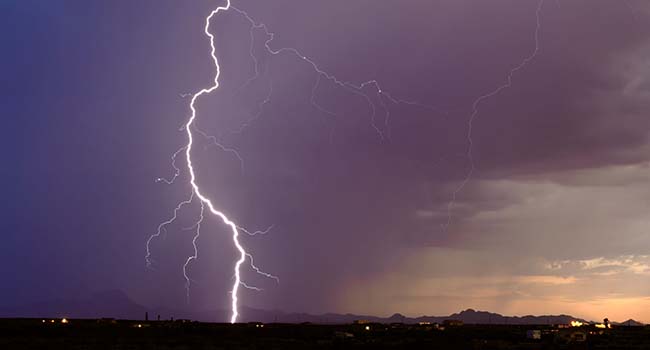It’s nearly that season again in the valley, the time of the year where high winds, relentless rainstorms and walls of dust tear through the city. The monsoon is a hallmark of the Arizona summer, one that longtime residents of the valley have become accustomed to. While the storms may seem routine and harmless to some, the monsoons actually have the potential to cause serious damage to homes and businesses. We talked to Eric Skoog, president of Sunvek Roofing, to find out how to best prepare your home for the looming monsoons.
The first step to take in preparing for the storms is to inspect, or have a professional inspect, your roof for imperfections. According to Skoog, there are two kinds of roof systems, flat and pitched roofs, each with their own list of things to keep an eye out for.
“With a flat roof you have a couple concerns,” Skoog said. “You want to make sure there’s no debris, no branches, no large objects which would block or plug where the water needs to drain off the roof. You don’t want open seams where water can get in underneath the roof system and into the structure.”
Skoog said almost all flat roof systems can be easily repaired by a professional with an acrylic or silicone coating.
The issues with pitched roofs tend to be surrounding penetration, Skoog said. Pitched roofs have long valleys where water runs down, and homeowners need to make sure these canals are clear of any rubble that may block the flow of water. The seals on the roof also need to be checked to make sure they are watertight.
Skoog stresses that the best way to make sure this is accomplished is to have your roof periodically inspected by a professional.
“If roofs are checked annually, then the building owner, whether a homeowner or a business owner, has little to worry about,” he said.
While calling a professional is the most important step to take, there are other measures homeowners can take immediately to make sure their home is better prepared for a potential monsoon. Homeowners should make sure all gutters and drain spouts are clear and hanging properly. If gutters are broken or hanging off-level, they will accumulate water. It’s also important to make sure drainage around the home is set up so that the water drains away from the foundation, leaving less of a chance for water to collect and damage the structure of the home.
Homeowners should also be aware of any potentially hazardous rocks or debris from plants in their yard. When the speed of the winds pick up, those objects can potentially be blown into your home and cause serious damage. Owners should also be cognizant of trees and plants in their yard growing too close to the house and endangering the roof.
“People like to have plants around their house and they look attractive, but if they’re not kept properly trimmed, then you have branches that damage the roof,” Skoog said. “Really it’s better not to have the trees and shrubbery too close to the house and especially not overhanging the roof. Buildings that have trees overhanging the roof also have problems with bees. For example, with a foam roof, they drill holes in the foam and lay their larva, or you may find beehives and other problems, not to mention the leaves and branches and other debris that accumulates on the roof.”
Skoog reiterated that while taking these measures will help minimize the potential property damage from a monsoon, it’s still critical to have a professional repair any imperfections in the roof, as many homeowners make common mistakes when attempting to do this themselves.
Skoog often sees cases where homeowners incorrectly overlap roofing material from the low side to the high side, so that water crawls underneath the loose flaps instead of merely running down the roof. Another common mistake he sees is people trying to seal up penetrations and accidentally seal it so water can’t get out, and runs into the house as a result.
Skoog said not calling a professional roofing inspector to find these kinds of imperfections may result, and has resulted in a collapsed roof. He frequently sees instances where a cable or telephone installer drilled holes in the roof and forgot to fill them back in, allowing water to flood into the house and cause severe damage.
He encourages all homeowners to have their roof inspected after any time a worker has been up on their roof. The important key to remember is to call a professional if you are unsure, to make sure you and your home stay safe this monsoon season.




